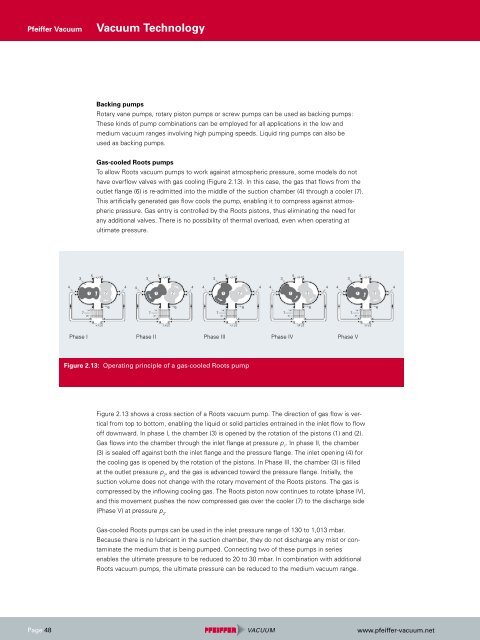You also want an ePaper? Increase the reach of your titles
YUMPU automatically turns print PDFs into web optimized ePapers that Google loves.
Pfeiffer <strong>Vacuum</strong><br />
Page 48<br />
4<br />
3<br />
7<br />
5<br />
<strong>Vacuum</strong> <strong>Technology</strong><br />
Backing pumps<br />
Rotary vane pumps, rotary piston pumps or screw pumps can be used as backing pumps:<br />
These kinds of pump combinations can be employed for all applications in the low and<br />
medium vacuum ranges involving high pumping speeds. Liquid ring pumps can also be<br />
used as backing pumps.<br />
Gas-cooled Roots pumps<br />
To allow Roots vacuum pumps to work against atmospheric pressure, some models do not<br />
have overflow valves with gas cooling (Figure 2.13). In this case, the gas that flows from the<br />
outlet flange (6) is re-admitted into the middle of the suction chamber (4) through a cooler (7).<br />
This artificially generated gas flow cools the pump, enabling it to compress against atmospheric<br />
pressure. Gas entry is controlled by the Roots pistons, thus eliminating the need for<br />
any additional valves. There is no possibility of thermal overload, even when operating at<br />
ultimate pressure.<br />
p1<br />
4 4<br />
4 4<br />
4 4<br />
4 4<br />
1 2<br />
1 2<br />
1 2<br />
1 2<br />
1 2<br />
p2<br />
6<br />
3<br />
7<br />
Phase I Phase II Phase III Phase IV Phase V<br />
Figure 2.13: Operating principle of a gas-cooled Roots pump<br />
5<br />
p1<br />
p2<br />
6<br />
3<br />
7<br />
5<br />
Figure 2.13 shows a cross section of a Roots vacuum pump. The direction of gas flow is ver-<br />
tical from top to bottom, enabling the liquid or solid particles entrained in the inlet flow to flow<br />
off downward. In phase I, the chamber (3) is opened by the rotation of the pistons (1) and (2).<br />
Gas flows into the chamber through the inlet flange at pressure p . In phase II, the chamber<br />
1<br />
(3) is sealed off against both the inlet flange and the pressure flange. The inlet opening (4) for<br />
the cooling gas is opened by the rotation of the pistons. In Phase III, the chamber (3) is filled<br />
at the outlet pressure p , and the gas is advanced toward the pressure flange. Initially, the<br />
2<br />
suction volume does not change with the rotary movement of the Roots pistons. The gas is<br />
compressed by the inflowing cooling gas. The Roots piston now continues to rotate (phase IV),<br />
and this movement pushes the now compressed gas over the cooler (7) to the discharge side<br />
(Phase V) at pressure p . 2<br />
Gas-cooled Roots pumps can be used in the inlet pressure range of 130 to 1,013 mbar.<br />
Because there is no lubricant in the suction chamber, they do not discharge any mist or contaminate<br />
the medium that is being pumped. Connecting two of these pumps in series<br />
enables the ultimate pressure to be reduced to 20 to 30 mbar. In combination with additional<br />
Roots vacuum pumps, the ultimate pressure can be reduced to the medium vacuum range.<br />
p1<br />
p2<br />
6<br />
3<br />
7<br />
5<br />
p1<br />
p2<br />
6<br />
3<br />
7<br />
5<br />
p1<br />
p2<br />
6<br />
4<br />
www.pfeiffer-vacuum.net

















